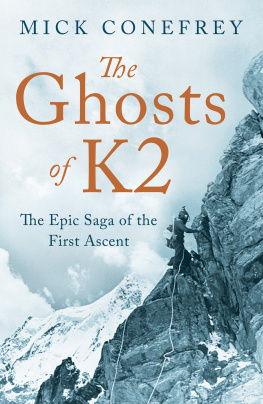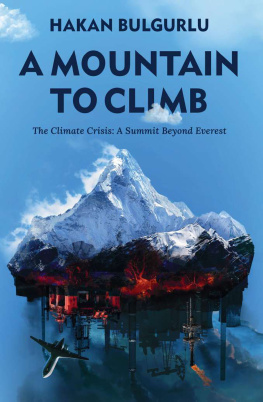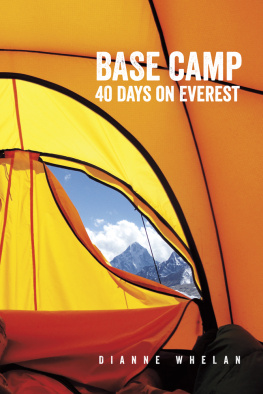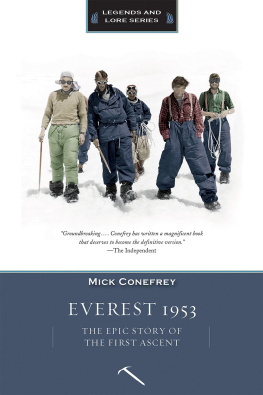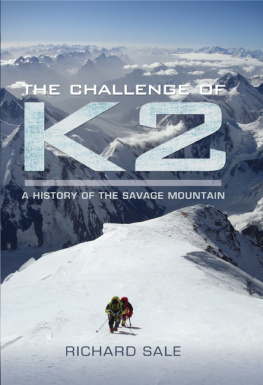A Oneworld Book
First published in North America, Great Britain and the Commonwealth by Oneworld Publications, 2015
This eBook published by Oneworld Publications, 2015
Copyright Mick Conefrey 2015
The moral right of Mick Conefrey to be identified as the Author of this work has been asserted by him in accordance with the Copyright, Designs, and Patents Act 1988
All rights reserved
Copyright under Berne Convention
A CIP record for this title is available from the British Library
ISBN 978-1-78074-595-4
ISBN 978-1-78074-596-1(eBook)
Typesetting and eBook by Tetragon, London
Maps Drawn by Adam T. Burton
Oneworld Publications
10 Bloomsbury Street
London WC1B 3SR
England
To Michael F.
List of
Illustrations
Prologue
The Mountain with No Name
On a small hill, next to a huge mountain on the border of Pakistan and China, theres a unique monument: a stone cairn some 10 ft high. It was built in 1953 to commemorate the death of a young American climber, Art Gilkey. In the decades since, it has been turned into a memorial for all the men and women killed trying to climb K2.
It is covered with small plaques. A few are elegantly embossed metal, cast thousands of miles away and then brought over by friends and relatives; others look as if they were hammered out on the spot from old tin plates. Some commemorate climbers who died on the way up, others remember those who perished on the way down. Several are famous names in the mountaineering world Alison Hargreaves, Nick Estcourt, Tadeusz Piotrowski others are less well known but equally missed. When the wind blows, and it often does, the plaques rattle against the rocks like sails in a marina.
Several hundred feet away, the brightly coloured tents of base camp stand out on the Godwin-Austen glacier, tiny specks in a timeless landscape of grey-brown rocks and endless fields of snow and ice. In the late spring there can be dozens of expeditions, but as the summer wears on they gradually leave, until there is nothing left but the wind and the snow.
Up above rises the huge mass of K2, almost five vertical miles of rock and ice. Occasionally the summit is revealed but for much of the time it is hidden behind dense layers of cloud. Though in theory K2 does not suffer the huge monsoon snowfalls that make climbing on Everest so difficult, the weather is very unpredictable and when storms come they can be severe. In January the temperature can drop to below 50 C. Combine that with hurricane-force winds of up to 70 miles per hour and its not surprising that no one has ever climbed K2 in winter.
At 28,251 ft, it is second in height to Everest and only just taller than its nearest rival, Kanchenjunga, but over the last century K2 has exerted a particular fascination upon the worlds climbers. It is the mountaineers mountain, the ultimate challenge: relentlessly steep slopes, extreme altitude, a remote location and unpredictable weather. On Everest there is a well-worn yak route to the top but on K2 there is no easy way up or down.
It is easy to see how K2 acquired its reputation as the toughest mountain in the world in the fifty years after the first ascent, 247 men and women reached the summit and 54 died trying. In more recent years, advances in equipment and technology have made K2 marginally safer to climb, but it still hits the headlines every few years with stories of the latest K2 tragedy.
K2 was first measured by Lieutenant Thomas George Montgomerie, a British officer working for the Great Trigonometrical Survey of India, one of the finest legacies of the British Raj. On 10 September 1856 he climbed Haramukh, a 16,000 ft peak in Kashmir, to set up a survey station. Some 130 miles away, he spotted two prominent peaks in the middle of the Karakoram, a long chain of mountains to the north west of the Himalayas.
After taking bearings, Montgomerie drew a small sketch in his notebook and named them K1 and K2, the K standing for Karakoram. As the survey progressed, several more K numbers were added to his list. In most cases, local names were subsequently found but K2 was just so remote, so hard to get to, that there was no agreed local name. In the end, despite several attempts to rechristen it, K2 has retained its original designation, an austere name for an austere mountain.
In the decades that followed Montgomeries first sighting, several travellers got closer to the mountain but no one attempted to climb it; their purpose was military rather than sporting. Britain and Russia were rivals in the so-called Great Game the Imperial struggle for the heart of Asia. The Russians, or so the British feared, wanted to spread south and eventually get a foothold in India; the British, or so the Russians feared, wanted to extend their empire north to the rich trading grounds of Central Asia. In order to gain the upper hand should either of these scenarios come to pass, both nations sent out soldiers and officials on secret missions to explore the unmapped regions.
The first of those explorers to see K2 was the British soldier Henry Haversham Godwin-Austen. In 1861 he set off on a mission to probe the glaciers of the Karakoram and determine whether K2 lay entirely within, or marked the northernmost border of, Kashmir. He got no closer than 16 miles to the great Peak K2, but came back claiming to be the first European to get a proper look at the mountain. In his honour, the glacier that runs along the eastern flank of K2 today bears his name, and on some maps the peak itself is called Mount Godwin-Austen.
A full twenty-six years later, Godwin-Austen was followed by another dashing young Sandhurst graduate, the splendidly named Francis Younghusband. As the remarkable climax to an epic journey across mainland China, Younghusband was asked by his superiors in British Intelligence to take a closer look at the Karakoram mountains from the Chinese side. For the twenty-four-year-old Younghusband, it was a perfect piece of derring-do for the glory of the British Empire:
I had no experience of mountaineering, and no Alpine equipment not even a pair of nailed boots, still less an ice-axe. And I had no money. I had already travelled nearly 3,000 miles across the Desert of Gobi and the plains of Turkestan. And now I was asked to cross the Himalaya by an unknown pass. It was just the kind of call I liked.
On 8 September 1887 Younghusband left Yarkand in China with eight men and thirteen ponies. Two weeks later they got within sight of K2. Though he never had any intention of climbing it, Younghusband wrote the first great literary homage to the mountain:
I chanced to look up rather suddenly, and a sight met my eyes which fairly staggered me. We had just turned a corner, which brought into view, on the left hand, a peak of appalling height, which could be none other than K2, at 28,278 in height second only to Mount Everest. Viewed from this direction, it appeared to rise in an almost perfect cone, but to an inconceivable height. We were quite close under it perhaps not a dozen miles from its summit and here on the northern side, where it is literally clothed in glacier, there must have been from fourteen to sixteen thousand feet of solid ice. It was one of those sights which impress a man forever, and produce a permanent effect upon the mind a lasting sense of the greatness and grandeur of Natures works which he can never lose or forget.

